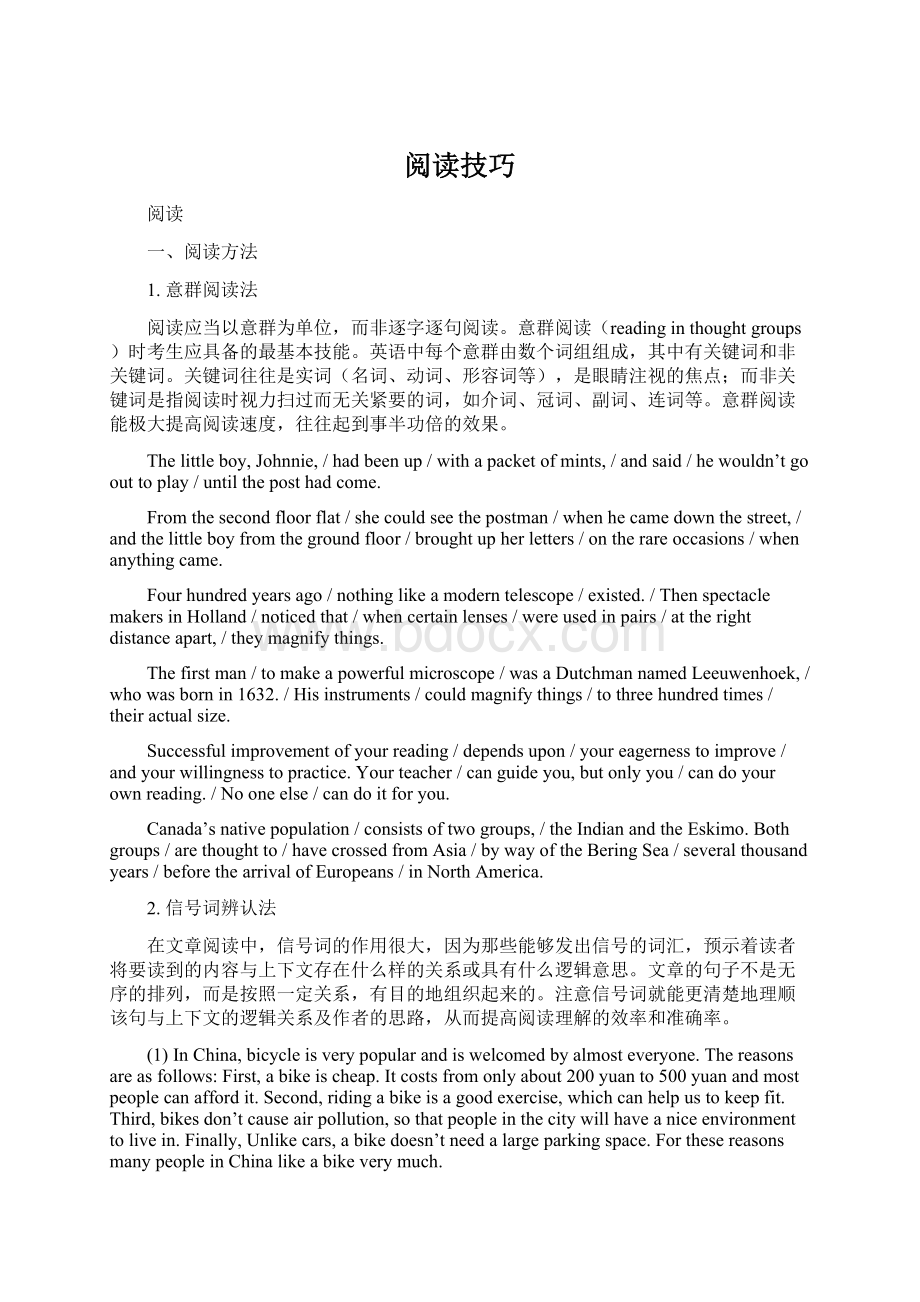阅读技巧.docx
《阅读技巧.docx》由会员分享,可在线阅读,更多相关《阅读技巧.docx(14页珍藏版)》请在冰豆网上搜索。

阅读技巧
阅读
一、阅读方法
1.意群阅读法
阅读应当以意群为单位,而非逐字逐句阅读。
意群阅读(readinginthoughtgroups)时考生应具备的最基本技能。
英语中每个意群由数个词组组成,其中有关键词和非关键词。
关键词往往是实词(名词、动词、形容词等),是眼睛注视的焦点;而非关键词是指阅读时视力扫过而无关紧要的词,如介词、冠词、副词、连词等。
意群阅读能极大提高阅读速度,往往起到事半功倍的效果。
Thelittleboy,Johnnie,/hadbeenup/withapacketofmints,/andsaid/hewouldn’tgoouttoplay/untiltheposthadcome.
Fromthesecondfloorflat/shecouldseethepostman/whenhecamedownthestreet,/andthelittleboyfromthegroundfloor/broughtupherletters/ontherareoccasions/whenanythingcame.
Fourhundredyearsago/nothinglikeamoderntelescope/existed./ThenspectaclemakersinHolland/noticedthat/whencertainlenses/wereusedinpairs/attherightdistanceapart,/theymagnifythings.
Thefirstman/tomakeapowerfulmicroscope/wasaDutchmannamedLeeuwenhoek,/whowasbornin1632./Hisinstruments/couldmagnifythings/tothreehundredtimes/theiractualsize.
Successfulimprovementofyourreading/dependsupon/youreagernesstoimprove/andyourwillingnesstopractice.Yourteacher/canguideyou,butonlyyou/candoyourownreading./Nooneelse/candoitforyou.
Canada’snativepopulation/consistsoftwogroups,/theIndianandtheEskimo.Bothgroups/arethoughtto/havecrossedfromAsia/bywayoftheBeringSea/severalthousandyears/beforethearrivalofEuropeans/inNorthAmerica.
2.信号词辨认法
在文章阅读中,信号词的作用很大,因为那些能够发出信号的词汇,预示着读者将要读到的内容与上下文存在什么样的关系或具有什么逻辑意思。
文章的句子不是无序的排列,而是按照一定关系,有目的地组织起来的。
注意信号词就能更清楚地理顺该句与上下文的逻辑关系及作者的思路,从而提高阅读理解的效率和准确率。
(1)InChina,bicycleisverypopularandiswelcomedbyalmosteveryone.Thereasonsareasfollows:
First,abikeischeap.Itcostsfromonlyabout200yuanto500yuanandmostpeoplecanaffordit.Second,ridingabikeisagoodexercise,whichcanhelpustokeepfit.Third,bikesdon’tcauseairpollution,sothatpeopleinthecitywillhaveaniceenvironmenttolivein.Finally,Unlikecars,abikedoesn’tneedalargeparkingspace.ForthesereasonsmanypeopleinChinalikeabikeverymuch.
(2)Whenthetelevisionwasinventedin1923,parentshadnoideaoftheharmfuleffectsthiscelebratedinventionwouldonedayhaveonchildren.BecauseofthetremendousamountoftimechildrenspendwatchingTV,theybecomepassiveobservers.SincechildrenspendmoretimeinfrontoftheTVandlesstimeonagoodbook,theirreadingabilitieshavealsosuffered.Asaresult,televisionhasanegativeeffectonchildren'slearningabilityandcreativity.Anotherharmfuleffectoftelevisioniscausedbytheexcessiveviolenceinmanypopularprograms.Consequently,youngstersimitatetheaggressivebehaviortheyseeonTV.Forallthesereasons,televisionhasdevelopedfromthemiracleitoncewasintothemonsteritistoday.
(3)GenerationsofAmericanshavebeenbroughtuptobelievethatagoodbreakfastisoneoflife'sessentials.Eatingbreakfastatthestartoftheday,wehaveallbeentold,andtoldagain,isasnecessaryasputtinggasolineinthefamilycarbeforestartingatrip.
Butformanypeoplethethoughtoffoodfirstthinginthemorningisbynomeansapleasure.Sodespitealltheefforts,theystilltakenobreakfast.Between1977and1983,thelatestyearforwhichfiguresareavailable,thenumberofpeoplewhodidn'thavebreakfastincreasedby33percent--from8.8millionto11.7million--accordingtotheChicago--basedMarketResearchCorporationofAmerica.
Forthosewhofeelpainofguiltaboutnoteatingbreakfast,however,thereissomegoodnews.Severalstudiesinthelastyearsindicatesthat,foradultsespecially,theremaybenothingwrongwithomittingbreakfast."Goingwithoutbreakfastdoesnotaffectperformance,"saidArnoldE.Bender,formerprofessorofnutritionatQueenElizabethCollegeinLondon,"nordoesgivingpeoplebreakfastimproveperformance."
Scientificevidencelinkingbreakfasttobetterhealthorbetterperformanceissurprisinglyinadequate,andmostoftherecentworkinvolveschildren,notadults.“Theliterature,”saysoneresearcher,Dr.ErnestoPollittattheUniversityofTexas,“ispoor.”
(4)Morethan30,000driversandfrontseatpassengersarekilledorseriouslyinjuredeachyear.Ataspeedofonly30milesperhouritisthesameasfallingfromathirdfloorwindow.Wearingaseatbeltsaveslives;itreducesourchanceofdeathorseriousinjurybymorethanhalf.
Thereforedriversorfrontseatpassengersover14inmostvehiclesmustwearaseatbelt.Ifyoudonot,youcouldbefinedupto50pounds.Itwillnotbeuptothedriverstomakesureyouwearyourbelt.Butitwillbethedriver'sresponsibilitytomakesurethatchildrenunder14donotrideinthefrontunlesstheyarewearingaseatbeltofsomekind.
However,youdonothavetowearaseatbeltifyouarereversing(倒退)yourvehicleoryouaremakingalocaldeliveryorcollectionusingaspecialvehicle;orifyouhaveavalid(有效)medicalcertificate(证书)whichexcusesyoufromwearingit.Makesurethesecircumstancesapplytoyoubeforeyoudecidenottowearyourseatbelt.Rememberyoumaybetakentocourtfornotdoingso,andyoumaybefinedifyoucannotprovetothecourtthatyouhavebeenexcusedfromwearingit.
二、如何猜测词汇
词汇(Vocabulary)是阅读理解测试中非常重要的一项。
词汇类其实也是就细节进行提问,所不同的是这是唯一关于词或词组的练习项目,词汇题往往要求对文章中的某个单词、短语甚至句子等找出近义词或最合适的解释。
阅读理解中词汇类问题的常见提问方式有下列几种:
(1)Accordingtotheauthor,theword"…"means_______.
(2)Whichofthefollowingisnearestinmeaningto"…"?
(3)Theterm".."inparagraph…canbebestreplacedby….
(4)What'sthemeaningof"…"inline…ofparagraph….?
(5)Asusedintheline…,theword"…"refersto_______.
一般来说,在文章的阅读中解决释义的最好办法是猜测词义。
猜测词义也需要一定的技巧。
1.利用文章中对词的定义或重复猜测词义
a.Theharborisprotectedbyajetty–awallbuiltoutintothewater.
b.Janeisindecisive,thatis,shecan’tmakeuphermind.
c.Suchexperiencesarenotunusualfortheamateurconchologists,peoplewhocollectshells.
d.Jackisnowaflorist,whokeepsashopforsellingflowersinourdistrict.
e.Hehadawanlook.Hewassopaleandweakthatwethoughthewasill.
f.Carbonmonoxideisanoxiousgaswhichcancausedeath.
g.Iamaresoluteman.OnceIsetupagoal,Iwon’tgiveitupeasily.
2.利用上下文词语意义的互相联系猜测词义
a.“Shewenttoschoolfor12yearsandshecan’twriteasentence?
”Timkensaid.“Theymadeanilliterateoutofmydaughter!
”
b.Timkenwasnowangry…Onceagainheflewintoarage.
c.JustbeforetheexamCarl’shandsshookandsweatedsomuchthathecouldnotholdapen.Hisheartbeatfastandhisstomachached,eventhoughheknewthatsubjectverywell.Hereallyhadastrangephobiaabouttakingtests.
d.Thefishermenmaketheircanoesfromtreetrunks.Theygofromislandtoislandintheselightnarrowboatsandcollectturtles'eggs
e.Jogginghasbecomeverypopularinsomecountries.Itisbelievedtobeagoodexerciseforoldpeople.
3.利用文章中对词的举例及解释猜测词义
a.Selectanyoftheseperiodicals:
Time,Newsweek,Reader’sDigestorTheNewYorker.
b.Sheisstudyingglaucomaandotherdiseasesoftheeye.
c.Todayyoungcoupleswhoarejuststartingtheirhouseholdsoftenspendlotsoftheirmoneyonappliances,forinstance,washingmachines,refrigeratorsandcolorTVs.
d.Finallytheenemysurrendered.Theythrewdowntheirweaponsandwalkedoutofthehomewiththeirhandsovertheirheads.
4.利用文章中词与词的同义和反义关系猜测词义
a.Thesnowwasfalling.Bigflakesdriftedwiththewindlikefeathers.
b.Thehot-airballoontookoff.Itwasasbuoyantintheairasacork(软木塞)inwater.
c.Ifyouhappenedtobesittinginthewoodsoutsidethecity,youmighthavewitnessedastrangesight.Youwouldhaveseenaveryproudlookingmanridingalonghorseback,sayingsomething
d.JanewastalkingwithotherswhileElizaremainedreticentallthetime.
e.Mostofusagreed;however,Billdissented.
f.Peterwasnotfrugalsincehespentmoneysofreely.
g.Inthenorthernregionsthewintersaregenerallycoldandhumid,andthesummershotanddry.
5.利用构词法知识(前缀和后缀)猜测词义
a.Theyoverestimatetheinterviewee'sabilityandaskedhimmanydifficultquestions
b.Weweretoldthatourswasthemostspaciousroominthehotel.Thatwaswhywehadtopaysomuchforit.
6.根据常识猜测词义
a.ThedoorwassolowthatIhitmyheadonthelintel.
b.Markgotonthemotorbike.Isatbehindhimonthepillion,andweroaredoffintothenight.
三、细节题
在做阅读时,除了首先要抓住文章的主旨和大意外,还必须弄清文中的一些重要细节或事实,因为它们是作者得出结论或阐明论点的依据。
换句话说,弄清文章中涉及的一些重要细节或事实有助于领会并确定文章的中心思想。
细节题的题型主要有两种:
(1)询问型:
(2)是非型:
1.Whichofthefollowingstatementsistrue?
/isnottrue?
2.Whichofthefollowingisnotincludedinthepassage?
3.Whichofthefollowingisnotmentionedinthearticle?
4.Allofthefollowingaretrueexcept_________.
5.Theauthormentionedalloftheitemslistedbelowexcept________.
6.Theauthor/passagedoesnottellus__________.
Thepopulationoftheworldhasincreasedmoreinmoderntimesthaninallotheragesofhistorycombined.Worldpopulationtotaledabout500millionin1650.Itdoubledintheperiodfrom1650-1850.Todaythepopulationismorethanthreebillion.EstimatesbasedonresearchbytheUnitedNationsindicatethatitwillmorethandoubleinthenexttwenty-fiveyears,reachingsevenbillionbytheyear2000.
1.By1850,approximatelywhatwastheworldpopulation?
A.500millionB.OnebillionC.ThreebillionD.sevenbillion
2.Worldpopulationdoubledintheyearsbetween______.
A.500-1650B.1650-1850C.1650-todayD.1850-2000
3.Accordingtothepassage,bytheyear2000theearth’spopulationshouldexceedthepresentfigureby_______.
A.500millionB.threebillionC.fourbillionD.sevenbillion
练习
(1)Whenaconsumerfindsthatanitemsheorheboughtisfaultyorinso